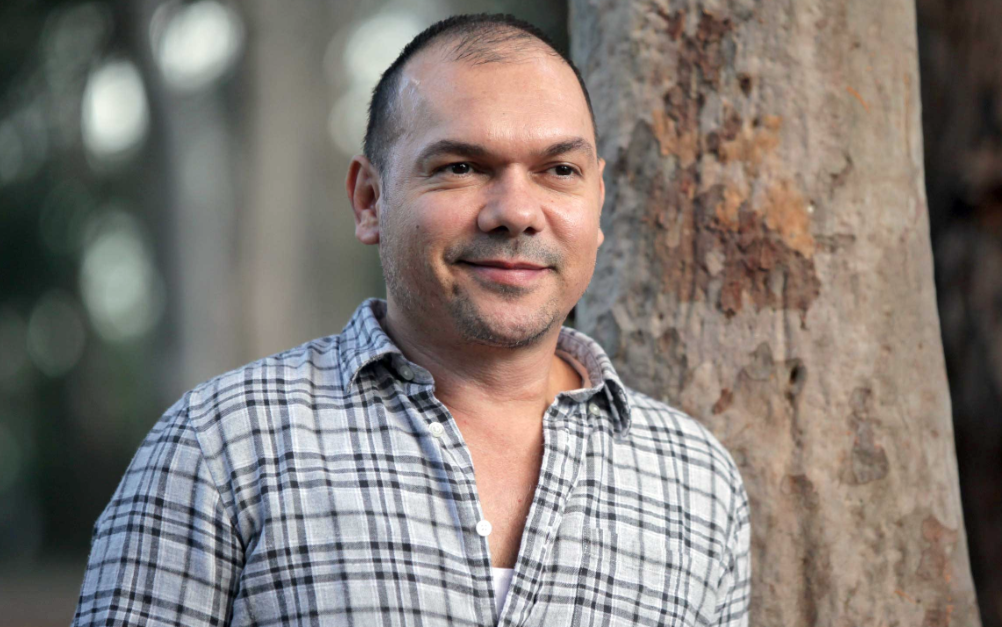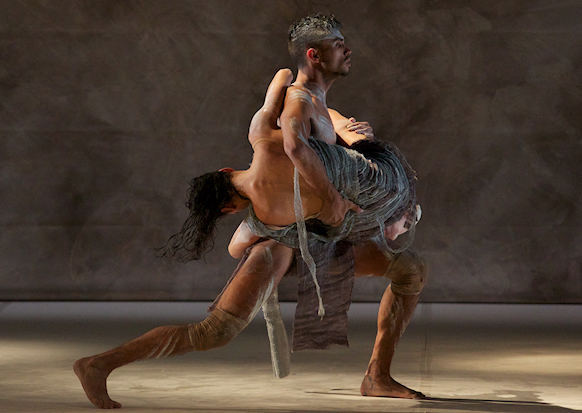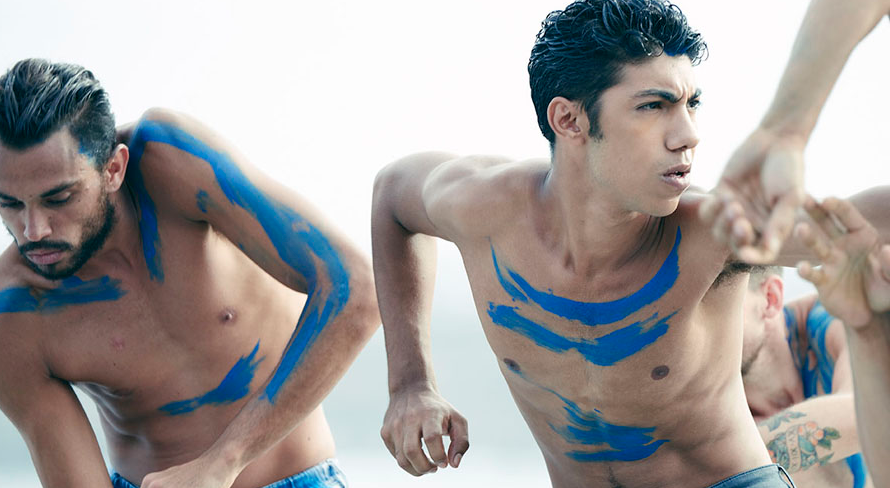Artistic Director Page unveils his 25th season at the helm of Australia’s award-winning indigenous dance troupe.

The coming year marks a special anniversary for Artistic Director and choreographer Stephen Page. It’s his 25th year at the helm of Bangarra Dance Theatre, Australia’s leading Indigenous dance company, and to celebrate he’ll be premiering a brand new work – his 23rd for the company.
Page is a descendent of the Nunukul people and the Munaldjali clan of the Yugambeh Nation from South East Queensland. For quarter of century, since his appointment as Artistic Director of Banagarra in 1991, he’s taken the story of his people and the other Aboriginal and Torres Strait cultures represented among his company around the world, and his accomplishments during this tenure reflect the strength of his leadership. In 2000, he oversaw Bangarra’s significant contributions to the opening and closing ceremonies of the Sydney Olympic Games, he was named NSW Australian of the Year in 2008 in recognition of his work uniting cultures through the performing arts, and he’s driven the company’s productions to win Best New Australian Work and Best Dance Work multiple times at the Helpmann Awards.
 Stephen Page
Stephen Page
“I never imagined when I took on the role 25 years ago what this small, ambitious company would become,” Page says. “We’re more than just a performing arts company, we’re now part of Australia’s cultural consciousness.” ‘Bangarra’ is a Wiradjuri word meaning “to make fire”, and the flame at the heart of Bangarra Dance Theatre is burning brighter than ever as the company enter 2016. 140 dancers have moved through the company over the years – with 16 dancers currently presenting work – but there’s always been a foundation of relationships that Page describes as being almost like a clan process inherited from their Aboriginal culture.
The duality of being both of the now and of the ancient past is inherent in almost everything this company stands for. Bangarra’s unique brand of dance theatre fuses the ancient vernacular of indigenous dance traditions with a more contemporary aesthetic, but in addition to creating superbly crafted stage works, this company also plays a vital role in communicating and preserving the stories and heritage of Aboriginal peoples. Over 90% of the dancers come from an urban background, with lineages that stem from a vast array of different clans from across Australia, and this melting pot of cultural heritage and contemporary experience is vital to their creative process.
“We’re more than just a performing arts company, we’re now part of Australia’s cultural consciousness.”
Every year the dancers will spend a few weeks on country, meeting with Aboriginal leaders and traditional families to strengthen relationships and learn more of themselves. This exchange isn’t always easy, as Page explains. “Sometimes you’re told, ‘You’re the yellow people from the south and we’re from the north, and you don’t have the language and it was assimilated’,” Page elaborates. “But we share stories with them, and I think when they see that we have this creative storytelling within us, they respect that.” In February, Bangarra will visit Yirrkla in North East Arnhem Land, and for the first time, the Tiwi Islands. The artists will come back spiritually recharged and creatively inspired, ready for a three-show season at Riverside Theatre in Parramatta, performing Frances Rings’ powerful hymn to Country set in Lake Eyre, Terrain.
As well as sharing the history of the Aboriginal nations, another major aspect of Bangarra’s artistic philosophy is centred on questioning the enduring social issues that are faced by indigenous Australians to this day. “Sometimes we don’t want to resolve them,” Page says, “sometimes we just want to give them a sense of hope and optimism, that the culture and the spirit and the land is probably going to be here another 40,000 years whether evolution or industry or technology keep going.”
 Frances Rings’ Terrain
Frances Rings’ Terrain
It’s a delicate balance to strike, but under Page’s leadership Bangarra have become a conduit, where a fruitful cultural exchange between indigenous and non-indigenous Australians can flourish. There is a sense of responsibility about the work that Bangarra does, but this is coupled with a welcoming atmosphere of education and generosity. The company also runs a youth program for secondary school students, which will head to Victoria and Western Australia for the first time in 2016, along with a return to Queensland.
The centrepiece of the upcoming season, celebrating his two and half decades with the company, is Page’s new work. Premiering later this year, it will tell the story of internationally acclaimed visual artist Nyapanyapa Yunupingu from North East Arnhem Land. “I’ve just been fascinated by her paintings, and I’ve had a great relationship with her about her stories,” Page says. The work is one of a trio of pieces, collectively titled Our Land People Stories, which will premiere on June 17 at the Sydney Opera House. Joining Page on the bill will be Jasmin Shepphard’s Macq, first performed in 2013, and another premiere, by Daniel Riley and Beau Dean Riley Smith. Together they have created Miyagan, a dance story mapping their cultural heritage in a discovery of their family background on Wiradjuri country in New South Wales.
 Hunter Page-Lochard in Spear
Hunter Page-Lochard in Spear
But before the 2016 season kicks off on stage, Page’s 25th anniversary year begins with the release of his debut film, Spear: a story of a young man seeking to reconcile the outback traditions of Australia within the urban modernity of Sydney’s bustling city, starring Page’s son, Hunter Page-Lochard. In recent years Bangarra’s stage productions have attracted impressive audience numbers – for example the company’s 25th anniversary production Patyegarang, which premiered in 2014, has been seen by over 36,000 people nationally. Now, Page moves the dancers from the stage to the screen to communicate their stories to an even greater audience on a global scale. “Film is such a beautiful medium, and it really did open my creative vision about how we could filter our stories,” Page says. “I was talking with a couple of filmmakers about the potency of our culture, and what is better when it’s set through the Indigenous eyes, and when it’s set through different mediums – from visual art to traditional art, to film, to dance. Film is such a completely different medium, you can get lost in it.”
Bangarra Dance Theatre has shown that past and future, heritage and innovation can coexist and offer a fascinating opportunity for cultural and creative exploration. This company continues to blaze a trail while remaining rooted in the Aboriginal and Torres Strait Islander stories that are central to its ethos. “There always seems to be this sense of clan attitude within the foundation,” explains Page. “It’s probably cliché, but we love to feel that we as artists are a new contemporary clan, paying homage to our heritage and living in the 21st century.”
Full details of Bangarra Dance Theatre’s 2016 season are available now. Spear is out on general release in cinemas from March 10.











Comments
Log in to join the conversation.